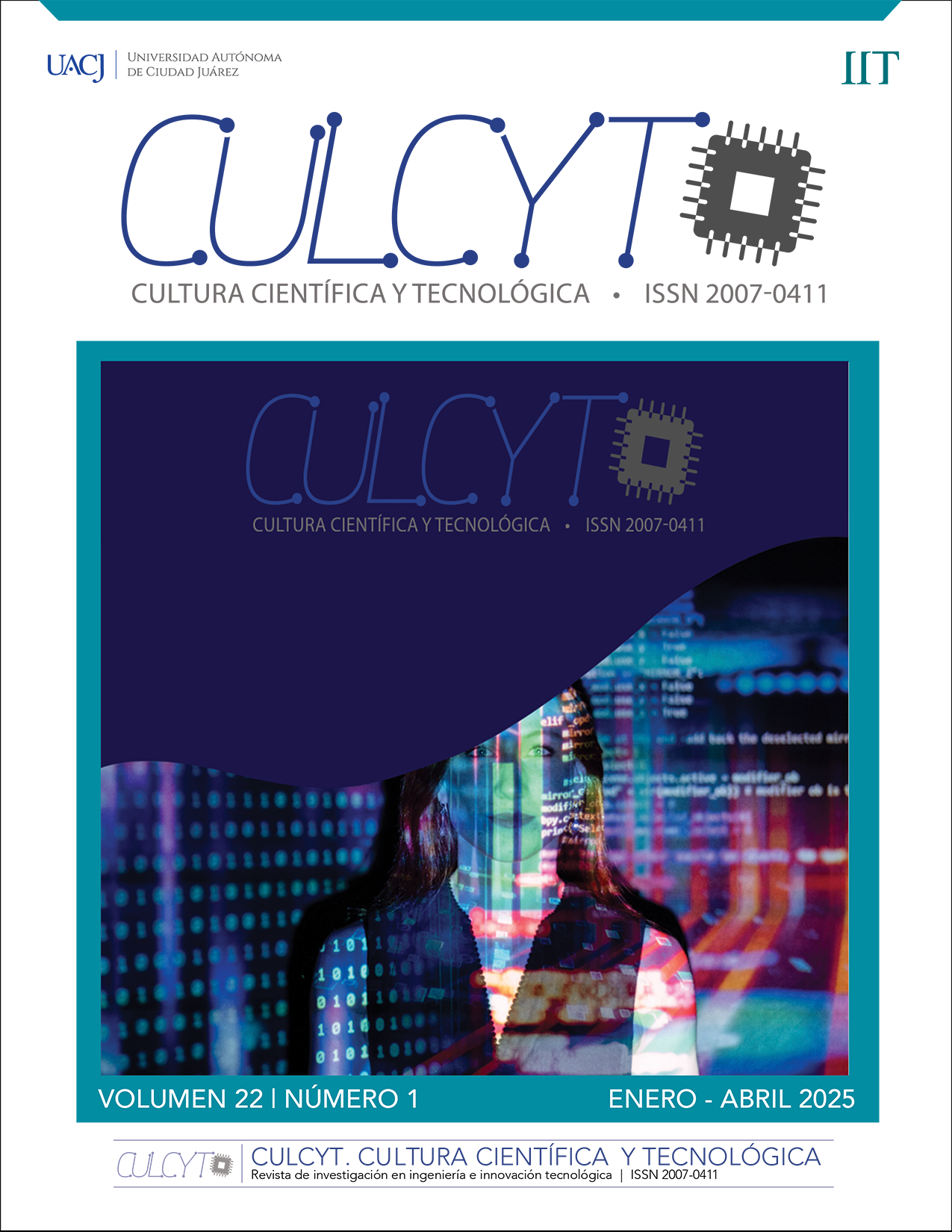Mechatronic Rehabilitation System for Upper Limbs
DOI:
https://doi.org/10.20983/culcyt.2025.1.2.1Keywords:
continuous passive motion, upper limb rehabilitation machine, rehabilitation robot, rehabilitation roboticsAbstract
Currently there is great interest in the development of machines that meet the demand to rehabilitate the upper and lower extremities, due to injuries caused by strokes, traumatic incidents or accidents, neuromuscular diseases, which are increasing day by day. The objective of this work is to present the kinematic analysis of an upper limb rehabilitation machine for patients who suffered a stroke. The rehabilitation machine has 3 degrees of freedom (DOF), uses a flexible cable, and can provide shoulder movements: flexion-extension, external rotation, abduction; and elbow flexion movements, among others. The kinematic analysis of some basic movements is presented by means of vector loop analysis. In addition, the simulation results in the MSC Adams environment show that the rehabilitation machine can provide smooth passive rehabilitation movements.
Downloads
References
N. Rehmat, J. Zuo, W. Meng, Q. Liu, S. Q. Xie and H. Liang, “Upper limb rehabilitation using robotic exoskeleton systems: a systematic review,” Int J Intell Robot Appl, vol. 2, pp. 283–295. 2018, doi: 10.1007/s41315-018-0064-8.
H. Shing Lo and S. Quan Xie, “Exoskeleton robots for upper-limb rehabilitation: State of the art and future prospects,” Med. Eng. Phys., vol. 34, no. 3, pp. 261–268, 2012, doi: 10.1016/j.medengphy.2011.10.004.
A. S. Niyetkaliyev, S. Hussain, M. H. Ghayesh and G. Alici, “Review on Design and Control Aspects of Robotic Shoulder Rehabilitation Orthoses,” in IEEE Transactions on Human-Machine Systems, vol. 47, no. 6, pp. 1134–1145, Dec. 2017, doi: 10.1109/THMS.2017.2700634.
R. A. R. C. Gopura, K. Kiguchi and D. S. V. Bandara, “A brief review on upper extremity robotic exoskeleton systems,” 2011 6th International Conference on Industrial and Information Systems, Kandy, Sri Lanka, pp. 346–351, 2011, doi: 10.1109/ICIINFS.2011.6038092.
Y. Huang, Q. Yang, Y. Chen and R. Song, “Assessment of Motor Control during Three-Dimensional Movements Tracking with Position-Varying Gravity Compensation,” Front. Neurosci., vol. 11, 2017, doi: 10.3389/fnins.2017.00253.
J. Niu, Q. Yang, X. Wang and R. Song, “Sliding Mode Tracking Control of a Wire-Driven Upper-Limb Rehabilitation Robot with Nonlinear Disturbance Observer,” Front Neurol., vol. 8, 2017, doi: 10.3389/fneur.2017.00646.
R. Beer, D. Mayhew, C. Bredfeldt and B. Bachrach, “Technical evaluation of the MACARM: A cable robot for upper limb neurorehabilitation,” 2008 2nd IEEE RAS & EMBS International Conference on Biomedical Robotics and Biomechatronics, Scottsdale, AZ, USA, pp. 942–947, 2008, doi: 10.1109/BIOROB.2008.4762880.
X. Li, Q. Yang and R. Song, “Performance-Based Hybrid Control of a Cable-Driven Upper-Limb Rehabilitation Robot,” in IIEEE Trans Biomed Eng, vol. 68, no. 4, pp. 1351–1359, April 2021, doi: 10.1109/TBME.2020.3027823.
Y. Zou, X. Wu, B. Zhang, Q. Zhang, A. Zhang and T. Qin. “Stiffness Analysis of Parallel Cable-Driven Upper Limb Rehabilitation Robot,” Micromachines, vol. 13, no. 2, 2022, doi: 10.3390/mi13020253.
K. Shi, A. Song, Y. Li and C. Wu, “Cable-driven Wearable Upper Limb Rehabilitation Robot,” 2018 IEEE International Conference on Robotics and Biomimetics (ROBIO), Kuala Lumpur, Malaysia, pp. 2434–2438, 2018, doi: 10.1109/ROBIO.2018.8665179.
Z. Li et al., “Mechatronics design and testing of a cable-driven upper limb rehabilitation exoskeleton with variable stiffness,” Rev. Sci. Instrum., vol. 92, no. 2, 024101, February 2021, doi: 10.1063/5.0037317.
A. Magadán, A. Blanco, José A. Santana, F. A. Gómez and E. Antúnez, “Diseño y control de un rehabilitador de hombro,” Pistas Educativas, no. 130, pp. 1764–1778, November 2018.
M. T. Angulo, A. Álvarez and Y. Fuentes, “Biomecánica Clínica. Biomecánica de la Extremidad Superior. Exploración del Codo,” REDUCA, vol. 3, no. 4, pp. 82–103, 2011.
Downloads
Published
How to Cite
Issue
Section
License
Copyright (c) 2025 Andrés Blanco Ortega, Carlos Manuel Lara Barrios, Milton Uriel Vargas Ortiz, Andrea Magadán Salazar, Manuel de Jesús Palacios Gallegos, Jonathan Villanueva Tavira

This work is licensed under a Creative Commons Attribution-NonCommercial 4.0 International License.
Todos los contenidos de CULCYT se distribuyen bajo una licencia de uso y distribución “Creative Commons Reconocimiento-No Comercial 4.0 Internacional” (CC-BY-NC). Puede consultar desde aquí la versión informativa de la licencia.
Los autores/as que soliciten publicar en esta revista, aceptan los términos siguientes: a) los/las autores/as conservarán sus derechos de autor y garantizarán a la revista el derecho de primera publicación de su obra; y b) se permite y recomienda a los/las autores/as agregar enlaces de sus artículos en CULCYT en la página web de su institución o en la personal, debido a que ello puede generar intercambios interesantes y aumentar las citas de su obra publicada.



